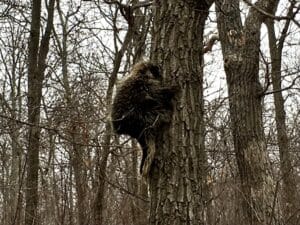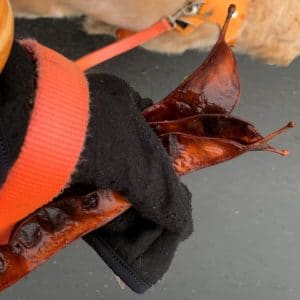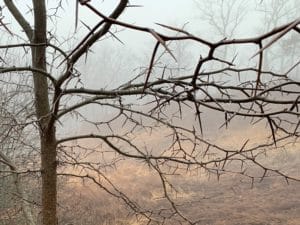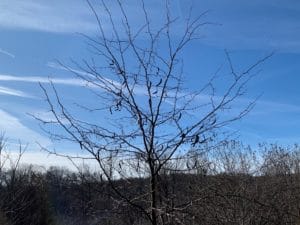Hello, fellow lovers of all things green,
I think of Honey Locust as the porcupine of trees (though there are thornless varieties, too) and adore their seed pods in winter window boxes. They are slightly twisted, about eight inches long, and nifty rust in color with a lovely sheen. I gathered them along the road on walks with Miss Ellie and now with Jolee. It’s a bumper crop, and the seedpods are longer than usual, likely due to the rainy summer.
The Honey Locust from which they came (Gleditsia triacanthos) looks imposing this time of the year; its sharp spikes are more prominent when the tree is naked of leaves. And, like the docile porcupine who uses their quills for protection, the spikes evolved to protect the tree from being browsed. It’s remarkable how nature creates mechanisms to protect critters and plants from predators.
The spikes protect Honey Locust from predators.
The two to four-inch spikes are often clustered along the trunk and spread out along the branches. They start soft and green before they harden to reddish-brown, then shift to grey. Thickets of Honey Locust provide a protective cover for animals and birds. And, like the porcupine, the spikes are harmless unless you tamper with the tree.
At other times of the year, the roadside Honey Locust catches my eye, too, especially in the fall when it turns a golden yellow. Its shaggy clusters of leaflets look almost fuzzy, becoming like Big Bird in the landscape. Then, when the leaves drop, the twisted seedpods hang like ornaments.
The sweet pulp of the seedpods gives the Honey locust its common name. White-tailed deer, opossums, raccoons, squirrels, and rabbits feast on them. As do goats and cattle who, along with sheep, also like the tender shoots in spring and the bark of young trees.
You can buy a thornless Honey Locust.
As beautiful as it is, the native Honey Locust is not typically available in the trades because of the spikes, though you can buy thornless varieties. And you can find the thornless Gleditsia triacanthos var. inermis growing in the wild.
They were once considered an ideal lawn tree, writes Michael Dirr in the go-to Manual of Woody Plants. They are fast-growing, two feet a year, and provide dappled shade, which allows grass to grow below it. However, their overuse has lessened their popularity.
Honey Locust is native from Pennsylvania to Iowa and south to Georgia and Texas. Growing thirty to seventy feet high and wide in Zones 3-9, it prefers six hours of direct sunlight daily. It’s remarkably adaptable, tolerating all types of soils, salt, pollution, moderate flooding, and drought. Plus, Honey Locusts are ideal on slopes to control erosion. They can live to be 120 years old, short-lived in tree years.
Popular thornless varieties of Honey Locust:
While its flowers aren’t showy, they’re fragrant and magnets for pollinators. An associate nurseryman, Ben Jansen of E.P. Jansen Nursery, says the flowers can create two inches of petal debris when they drop, a nuisance to some. He describes Honey Locusts as opportunistic but not aggressive, with shallow root systems that go well beyond their canopy if needed.
Ben sells primarily ‘Skyline,’ with few seed pods and excellent yellow fall color, ‘Shademaster,’ without flowers or seed pods, and ‘Sunburst’ (Golden), also thornless and seedless.

I stumbled upon this fellow in January along the Appalachian Trail
Porcupines can be a Garden Nuisance.
Speaking of porcupines, they are primarily nocturnal and don’t hibernate. And it’s winter when they can wreak havoc on trees by eating the bark and evergreen needles, which is why they are often found in wooded areas. But they can damage your garden, feasting on root vegetables, berries, fruit, and nuts.
If they become a problem, you can capture them in an animal trap and move them along or install an electric fence. There are products such as Critter Ridder. Or use hot sauce or capsaicin, a chili pepper extract, on plants and trees to prevent porcupine damage and deter them from your garden (just be sure to rinse your vegetables thoroughly before you eat them.)
Come spring, I’ll disperse the Honey Locust seedpods that adorn the window boxes. It occurs to me that bringing them elsewhere is much like how birds and other critters transport seeds from here to there in nature. Nature’s way of sharing gifts and growing them forward. May we all do the same.
Garden Dilemmas? AskMaryStone@gmail.com (and your favorite Podcast App.)
There’s much more to the story on the Garden Dilemmas Podcast:
You may recall way back in Three Sisters Gardening & Jolee’s Emergency, Jolee stepped on a baby porcupine while on a hike and how kind passersby stepped in to help us.
Link to Decorating with Leave Behinds to view the window box graced with Honey Locust seedpods.
More Tips on How to Get Rid of Porcupines
USDA Honey Locust Plant Fact Sheet





